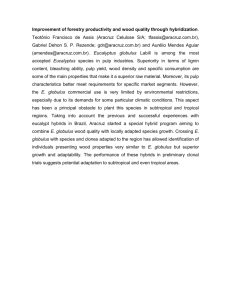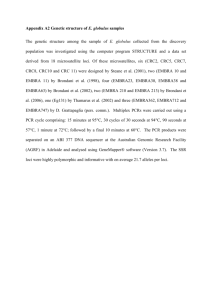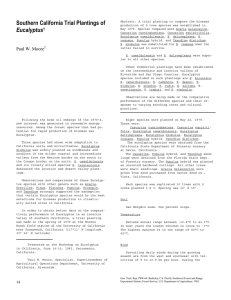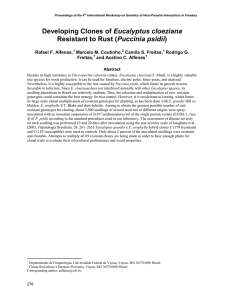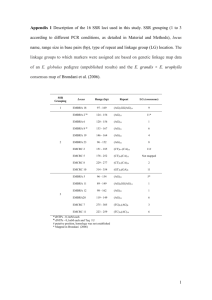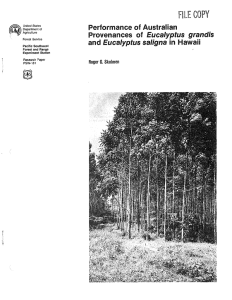Document 11236037
advertisement
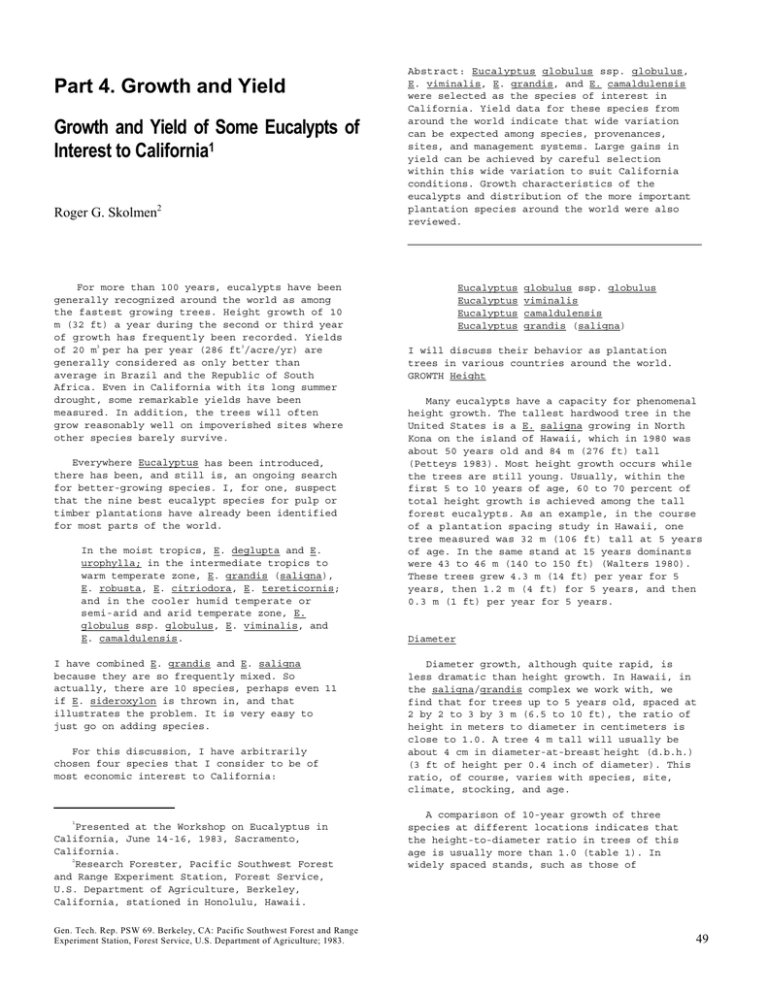
Part 4. Growth and Yield Growth and Yield of Some Eucalypts of Interest to California1 Roger G. Skolmen2 For more than 100 years, eucalypts have been generally recognized around the world as among the fastest growing trees. Height growth of 10 m (32 ft) a year during the second or third year of growth has frequently been recorded. Yields 3 3 of 20 m per ha per year (286 ft /acre/yr) are generally considered as only better than average in Brazil and the Republic of South Africa. Even in California with its long summer drought, some remarkable yields have been measured. In addition, the trees will often grow reasonably well on impoverished sites where other species barely survive. Everywhere Eucalyptus has been introduced, there has been, and still is, an ongoing search for better-growing species. I, for one, suspect that the nine best eucalypt species for pulp or timber plantations have already been identified for most parts of the world. In the moist tropics, E. deglupta and E. urophylla; in the intermediate tropics to warm temperate zone, E. grandis (saligna), E. robusta, E. citriodora, E. tereticornis; and in the cooler humid temperate or semi-arid and arid temperate zone, E. globulus ssp. globulus, E. viminalis, and E. camaldulensis. I have combined E. grandis and E. saligna because they are so frequently mixed. So actually, there are 10 species, perhaps even 11 if E. sideroxylon is thrown in, and that illustrates the problem. It is very easy to just go on adding species. For this discussion, I have arbitrarily chosen four species that I consider to be of most economic interest to California: 1 Presented at the Workshop on Eucalyptus in California, June 14-16, 1983, Sacramento, California. 2 Research Forester, Pacific Southwest Forest and Range Experiment Station, Forest Service, U.S. Department of Agriculture, Berkeley, California, stationed in Honolulu, Hawaii. Gen. Tech. Rep. PSW 69. Berkeley, CA: Pacific Southwest Forest and Range Experiment Station, Forest Service, U.S. Department of Agriculture; 1983. Abstract: Eucalyptus globulus ssp. globulus, E. viminalis, E. grandis, and E. camaldulensis were selected as the species of interest in California. Yield data for these species from around the world indicate that wide variation can be expected among species, provenances, sites, and management systems. Large gains in yield can be achieved by careful selection within this wide variation to suit California conditions. Growth characteristics of the eucalypts and distribution of the more important plantation species around the world were also reviewed. Eucalyptus Eucalyptus Eucalyptus Eucalyptus globulus ssp. globulus viminalis camaldulensis grandis (saligna) I will discuss their behavior as plantation trees in various countries around the world. GROWTH Height Many eucalypts have a capacity for phenomenal height growth. The tallest hardwood tree in the United States is a E. saligna growing in North Kona on the island of Hawaii, which in 1980 was about 50 years old and 84 m (276 ft) tall (Petteys 1983). Most height growth occurs while the trees are still young. Usually, within the first 5 to 10 years of age, 60 to 70 percent of total height growth is achieved among the tall forest eucalypts. As an example, in the course of a plantation spacing study in Hawaii, one tree measured was 32 m (106 ft) tall at 5 years of age. In the same stand at 15 years dominants were 43 to 46 m (140 to 150 ft) (Walters 1980). These trees grew 4.3 m (14 ft) per year for 5 years, then 1.2 m (4 ft) for 5 years, and then 0.3 m (1 ft) per year for 5 years. Diameter Diameter growth, although quite rapid, is less dramatic than height growth. In Hawaii, in the saligna/grandis complex we work with, we find that for trees up to 5 years old, spaced at 2 by 2 to 3 by 3 m (6.5 to 10 ft), the ratio of height in meters to diameter in centimeters is close to 1.0. A tree 4 m tall will usually be - about 4 cm in diameter-at-breast height (d.b.h.) (3 ft of height per 0.4 inch of diameter). This ratio, of course, varies with species, site, climate, stocking, and age. A comparison of 10-year growth of three species at different locations indicates that the height-to-diameter ratio in trees of this age is usually more than 1.0 (table 1). In widely spaced stands, such as those of 49 E. camaldulensis in Morocco, diameter growth is still sufficient at age 10 to maintain the ratio at about 1.0. Site has a stronger influence on the ratio with the other species and levels of stocking. Eucalyptus grandis in South Africa greatly exceeds the other species in height growth. The criteria for separating good, fair, and poor sites are height measurements at age 10, Table 1--Ratio of height in meters (h) to diameter in centimeters (d) at age 10 by species, site, and stocking. Species and location Eucalyptus globulus Stocking (stems/ha) 2500 North Spain Eucalyptus globulus Height h/d 1100 Portugal Eucalyptus camaldulensis Good Height h/d 800 Height 22.0 1.57 27.0 1.39 15.6 Site Fair 16.0 1.42 19.0 1.26 13.0 Other data (FAO 1979) indicate that by volume rather than weight, stems of ssp. globulus in Italy were 15 to 20 percent bark, depending on their diameter. For pulp yields this is important because ssp. globulus bark is used in most pulping processes. On the other hand, E. camaldulensis bark, which is not used in pulp, made up 20 to 30 percent of stems under 20 cm (8 inches) in Italy. Eucalyptus grandis bark, also not desired in pulp, was about 15 percent in small trees in three countries reported. Poor 13.0 1.31 Table 2--Biomass percentages in Eucalyptus globulus grown in Australia. 11.0 Age (years) 1.29 10.4 4 6 Stem Wood Bark 67.0 55.5 11.5 71.7 57.1 14.6 YIELD Branches Live Dead 16.5 12.0 4.5 12.7 9.8 2.9 Volume Leaves 16.5 15. Morocco Eucalyptus grandis South Africa h/d 1100 Height h/d 0.95 34.8 1.76 0.95 28.4 1.55 0.95 20.2 1.19 Source: FAG 1979, P. 310. Tree volume is measured and reported in many different ways around the world, so it is important to look at what is being measured when reviewing the literature. Frequently, this important information is not reported. Most commonly, total stem volume over bark is used. It is determined with d.b.h., total height, and a form factor, which in Third World countries is usually a ratio of volume to basal area times height--the old "artificial form factor" of European forestry (Assman 1970). Some volume tables allow for stump height, some are to a top diameter, some are for volume under bark, and some are of stacked volume (FAO 1979). The volume figures I report here are all for total height over bark, unless otherwise specified. Biomass Data on total biomass are scarce, but of great interest currently. In Australia, Cromer and others (1975) found E. globulus ssp. globulus seedlings to have a weight yield at 4 years made up of 55.5 percent stemwood, 11.5 percent bark, 16.5 percent branchwood, and 16.5 percent leaves (table 2). At age 6, the percentage of stemwood had increased slightly while the percentage of branchwood decreased (FAO 1979); percentage of leaves remained the same. Data I collected in three ssp. globulus coppice stands in Hawaii gave 72 percent of the dry weight yield in stems and bark at age 3, 76 percent at age 4, and 77 percent at age 5. So it appears that with both seedlings and coppice of this species we can expect 70 to 75 percent of weight yield of young trees to be in stems and bark. 50 Material Source: FAO 1979, p. 315. Weight Weight is an important consideration in growing fuelwood or pulpwood. Most eucalypts produce light-weight wood when very young and then increasingly denser wood with age. During the first 5 to 10 years, wood density increases along radial and height gradients, and in trees of the same age, the wood of highest average specific gravity will be found in the largest and tallest trees. Rapid diameter and height growth do not necessarily result in reduced average wood density as would be expected (King 1980). However, wood density of young trees is often much less than that of mature trees, which is the density usually reported in the literature. In Hawaii, a study done in 1978 indicated that dry weight of 2- to 5-year-old ssp. globulus coppice ranged with stand age from 3 3 421 to 494 kg/m (26 to 31 lb/ft ) in samples from the lower 2 m (6.5 ft) of the stem (Skolmen 1980). This is only 70 percent of the dry weight of mature wood. Three years later, in 1981, we sampled 40 trees in the stands, which were then 7 and 8 years old. Specific gravity at breast height remained the same, but 3 samples from 6 m (20 ft) averaged 511 kg/m 3 (32 lb/ft ). The wood density increased with height. Elsewhere in Hawaii, specific gravity at 2 years of age was 0.39 for E. saligna and 0.36 for E. grandis (Bioenergy Dev. Corp. 1983). Mature trees of these species have wood that ranges from 0.50 to 0.60 in specific gravity. It may be necessary to carry eucalypts for a longer rotation than planned merely to increase average density. EUCALYPTUS GLOBULUS SSP. GLOBULUS Eucalyptus globulus ssp. globulus is the common bluegum that was originally introduced into California from Tasmania or the southern part of the state of Victoria. Probably because its juvenile foliage is unpalatable to cattle, it was favored in early introductions and widely planted (FAO 1979). Today, because of its rapid growth and adaptability to a wide variety of site conditions, it is one of the most planted of all eucalypts around the world. It has been particularly successful in countries with a Mediterranean climate such as California, Portugal, Spain, Chile, and the western part of the Republic of South Africa. In Portugal, where it is by far the most common species planted, there are 238,000 ha (588,000 acres) of E. globulus (FAO 1979). Most plantations are near the coast in northwest Portugal where the annual rainfall normally exceeds 850 mm (33 inches). Stands are worked on a coppice rotation of 10 to 12 years for the production of paper pulp and firewood. Mean annual increment (MAI) ranges from 12 to 30 3 3 m /ha/yr (172 to 429 ft /acre/yr) (Turnbull and Pryor 1978). In Spain, bluegum grows on 205,000 ha (492,000 acres) (FAO 1979). In the Huelva Province near sea level, where the very seasonal annual rainfall is 440 mm (17 inches) bluegum 3 produces only 4 to 8 m /ha/yr (57 to 114 3 ft /acre/yr) of wood which is used for pulp and mine props. In the north, where rainfall is evenly distributed and exceeds 1000 mm (39 inches), production is more like that in 3 Portugal, ranging from 12 to 20 m /ha/yr (172 3 to 286 ft /acre/yr). In Chile, large areas of bluegum are managed on coppice rotations of 5 to 20 years for firewood, charcoal, and mine props. In a zone of annual rainfall of over 1200 mm (47 inches), ssp. globulus withstands temperatures down to -7° C (20° F) and is reported to grow in areas with annual rainfall as low 350 mm (14 inches). It also grows extensively in Argentina, Uruguay, Peru, Bolivia, and Ecuador (Turnbull and Pryor 1978). In Hawaii, bluegum was planted in the early 1900's and did quite well at higher elevations of 1200 to 1800 m (4000 to 6000 ft). At this elevation range, good yields sometimes exceed 3 1400 m /ha (100,000 fbm/acre) in 60-year-old stands. At lower elevations in Hawaii, the species frequently produces short, stunted trees with extremely spiralled grain. Bluegum coppices very well and forms lignotubers, which will live for many years in the soil if the stem dies back due to suppression. These will sprout after the rest of the stand is logged. In our coppice stands in Hawaii we normally get coppice on the stumps as well as coppice from these buried lignotubers. In addition, a stand of seedlings usually becomes established along with the coppice (Skolmen 1980). In Hawaii we studied E. globulus coppice that came in after logging four 64-year-old stands. These bluegum stands were similar to those in California of about the same age and diameter. Four stands involved in this study were growing at an elevation of about 1200 m (4000 ft) and receiving 1250 to 2000 mm (50 to 80 inches) of rain per year. The four stands had been logged during consecutive years between 1973 and 1976. When measured, 2, 3, 4, and 5 years had passed since logging. Despite the age of the stumps, 70 to 80 percent of them had coppiced. But we found that about half the volume in the stands was from stems that had sprouted from buried lignotubers that had been present before logging. These lignotubers were the remnants of suppressed stems that had died and disappeared. In addition to the coppice, all stands had seedlings, which made up more than 20 percent of the total number of stems in all stands but contributed very little to the volume as they were usually suppressed by the coppice. MAI 3 varied from 10.4 to 14.0 m /ha/yr (150 to 200 3 ft /acre/yr) among the unmanaged 2- to 6-year-old coppice stands over two years of measurement (Skolmen 1980). In this coppice study, stems with bark intact averaged 60 percent moisture content calculated on a fresh weight basis. During normal logging in Hawaii, when stems are converted into chips we find that moisture content is generally reduced to about 50 percent if the bark is included. This is often considered high moisture content by boiler engineers who usually specify no more than 42 percent. In Hawaii, we cannot deliver freshly felled E. globulus with this low a moisture content unless the stems are debarked. In coppice yields worldwide, first coppice crop volume generally exceeds the volume of the seedling crop by 20 to 25 percent (FAO 1979). Studies in Portugal (FAO 1979) indicated that the second coppice crop with E. globulus ssp. globulus should be about 80 percent of the initial seedling crop and the third coppice crop less than 80 percent. In our coppice study in Hawaii, the mean annual increment of total above-ground biomass ranged from 7.8 to 10.6 t/ha/yr (3.5 to 4.7 tons/acre/yr). Seventy percent of the weight was in the stems (Skolmen 1980). Distribution of weight among the different types of stems was 50 percent coppice on stumps, 11 percent seedlings, and 39 percent coppice from buried lignotubers. 51 In Australia, Cromer and others (1975), found that at age 4, unfertilized seedlings of ssp. globulus produced 12 t/ha (5.3 tons/acre) of total biomass (dry) including branches and leaves. These same plots at age 6 produced 25 t/ha (11.1 tons/acre) for a mean annual increment in weight of 4 t/ha/yr (1.8 tons/acre/yr). Plots that were fertilized produced 90 t/ha (40 tons/acre) or 15 green t/ha/yr (6.7 tons/acre/yr). It was further found that the percentage of weight in stems versus branches and leaves did not vary with the various fertilizer or control treatments. 3 With bluegum, MAI of 10 m /ha/yr (143 ft /acre/yr) is considered typical on poor 3 sites, while very good sites yield up to 35 m 3 (500 ft ) (FAO 1979). 3 Considerable growth information has been gathered for ssp. globulus in Portugal and Spain (FAO 1979). For a good site in Portugal, at age 3 2, there was a MAI of 10 m /ha/yr (143 3 ft /acre/yr), which peaked at age 12 (fig. 3 3 1). At age 10 MAI was 38 m (543 ft ). The dry weight of ssp. globulus wood is about 600 3 3 kg/m (37 lb/ft ). The green weight, because the stem is about 50 percent water, 3 3 would be 1200 kg/m (74 lb/ft ). The weight increment at 10 yr is therefore about 45.6 t/ha/yr (20 tons/acre/yr) on the best site. This is the elusive 10 dry tons/acre/yr of biomass that managers strive for. The poor site 3 3 at 2 years had a MAI of only 2 m (28.6 ft ) 3 3 and similarly at age 10 only 8 m (114 ft ), so site has a major effect on yield. Figure 2--Eucalyptus globulus ssp. globulus, N. Spain 2700 per hectare drop off after 6 years. By age 10, on the poor 3 site, yield was down to 15.2 m /ha/yr (217 3 ft /ha/yr), whereas at the close spacing used, 3 3 18.8 m (263 ft ) was achieved at age 4. In southwestern Spain, on a much drier site, a much wider spacing had to be used, and MAI was much less (fig. 3)--at age 9, on the very best 3 3 site, only 8 m /ha/yr (114 ft /acre/yr). On the worst site at age 9, yield was only 0.8 3 3 m /ha/yr (11.4 ft /acre/yr). I suspect this might be comparable to the conditions in southern California in most years. At a somewhat better area in southwestern Spain at 9 3 years on the good site, MAI was 16.2 m /ha/yr 3 (232 ft /acre/yr) (fig. 4). On the poor site, 3 this went down to 0.9 m /ha/yr (13 3 ft /acre/yr). Figure 1--Eucalyptus globulus ssp. globulus, Portugal 1100 per hectare. In northern Spain, with stocking double to triple the stocking of the stands in Portugal, 3 3 at age 4, MAI was 27.5 m (393 ft ) on the best site (fig. 2). At age 10, it was up to 44 3 3 M (629 ft ). The northern Spain sites are quite comparable to the sites in Portugal. On the fair site in northern Spain, MAI began to 52 Figure 3-- Eucalyptus globulus ssp. globulus S. W. Spain (sandy) 600 per hectare. 87,000 ha (215,000 acres). It is also the tree most commonly planted in Israel. Figure 4--Eucalyptus globulus ssp. globulus, S.W. Spain (shale) 600 per hectare. EUCALYPTUS VIMINALIS The principal advantage of E. viminalis as a plantation tree over the other three eucalypts is that it will withstand cooler temperatures. It is suitable for cool climates such as in northern California, that are subject to moderate frosts. This species has been widely planted in southern Brazil, Argentina, Italy, and the Black Sea area of the Soviet Union. It is also considered promising in Chile, Portugal, Spain, and Turkey. Its main use is as a short-rotation fiber crop for pulp and hardboard production. In Spain, several thousand hectares have been planted on sites that are too cold for ssp. globulus, and at 450 m (1500 ft) elevation it 3 3 yields about 12 m /ha/yr (172 ft /acre/yr) (FAO 1979). Eucalyptus viminalis is considered a good plantation species. It coppices very well, and the coppice does not die back easily in winter. In Australia, the species has a wide latitudinal range and many provenances, so is a very suitable one for provenance testing. The trees can withstand temperatures of -10° C (15° F), but in Russia were killed by temperatures of near -16° C (0° F) (FAO 1979). EUCALYPTUS CAMALDULENSIS In addition to its ability to withstand long drought, camaldulensis also has some resistance to frost and is a vigorous coppicer. However, the stem is usually more crooked than E. globulus or grandis, two of the other most frequently used trees. Also, the crowns are rather thin so stands are more prone to weed invasion than those of some of the other denser crowned eucalypts. This, incidentally, might be considered a desirable characteristic by those concerned about creating biological deserts by planting eucalypts that prevent understory growth. The wood is heavier, harder, and, more deeply colored than E. globulus or grandis and therefore, not as good for pulp. However, the wood is better than either of the other species for fuelwood because of its high density (FAO 1979). There has been more provenance testing with this species than any other of the eucalypts, probably because it has more provenances. Some of the results obtained suggest the extreme importance that provenance testing be done in the areas where unknown seed sources are already doing well. An example is a test done at Afaka in Nigeria (table 3). Five-year-old trees had 3 MAI that ranged from 17.3 m /ha/yr (247 3 3 ft /acre/yr) to 5.1 m /ha/yr (73 3 ft /acre/yr), depending on where in Australia the seed had come from. This demonstrates a possible three-fold increase in yield achieved simply by selecting seed source location. Table 3--Eucalyptus camaldulensis provenance test at Afaka, Nigeria. Seed source Petford, Q. Katherine, N.T. Wiluna, W.A. Alice Springs, NT Bourke NSW Wohlpooer V Menger's Hill S.A. Walpole NSW 17°20' 14°20' 26°38' 23°08' 31°54' 37°00' 34°30' 34°10' Rainfall Elevation mm m 716 958 249 252 234 606 1182 247 518 110 490 580 210 300 610 90 5-year growth Height MAI m 17.8 15.1 14.2 14.8 11.4 13.2 10.4 12.4 m3/ha/yr 17.3 14.1 11.3 9.4 8.3 7.6 5.4 5.1 Source: FAO 1979, p. 375. 1 Eucalyptus camaldulensis is the widest ranging eucalypt in Australia, so there are many provenances suitable for a great many different sites. Its principal desirable feature as an introduced plantation tree is its ability to withstand lengthy and severe drought. The tree can also withstand periodic flooding and was one of the first species to be taken from Australia and planted elsewhere, having been planted in Italy as early as 1803. Today, around the world, there are estimated to be more than a half million hectares of E. camaldulensis in plantations, especially around the Mediterranean. Spain has more than 100,000 ha (247,000 acres). In Morocco, there are about Latitude MAI = Mean annual increment. Growth varies greatly according to climate and soil. On good sites MAI of 2 m (6.5 ft) in height and 2 cm (0.8 inch) in diameter may be maintained for the first 10 years. But on poorer and drier sites, growth is reduced to 1 m (3.3 ft) in height and 1 cm (0.4 inch) in diameter per year. Volume yields of 20 3 3 m /ha/yr (286 ft /acre/yr) are reported from Argentina, and on the very best sites in Israel, 3 3 as much as 30 m (425 ft ) may be obtained. 3 3 In Turkey, 20 m (286 ft ) can be obtained on good sites in the initial seedling rotation 3 3 and 30 m (425 ft ) in subsequent coppice rotations. However, on poorer and drier sites, 53 Figure 5--Eucalyptus camaldulensis, Morocco 800 per hectare. much lower yields can be expected. Other countries report corresponding yields (FAO 1979). Most E. camaldulensis plantations are managed on coppice rotations of 7 to 10 years on better sites, and longer on poor sites. In Spain, for example, rotations are 14 to 15 years. The first coppice rotation is expected to produce a higher yield than the initial seedling rotation and the length of the rotation may be adjusted accordingly. For example, in Morocco, a seedling rotation of 12 years is common followed by 7 years for the first coppice rotation and 10 years for the second (FAO 1979). Yield variation of E. camaldulensis on three sites in Morocco at a spacing of 3.5 by 3.5 m (11.5 by 11.5 ft) is believed to be typical for this species (fig. 5). MAI at age 6 was 5.8 3 3 3 m (83 ft ) and at age 10 it was 9 m (129 3 ft ) and still rising. On the medium site, at 3 3 age 6, MAI was only 3.9 m (56 ft ) and at 3 3 age 10, 5.4 m (77 ft ). On the poor site, at 3 3 age 6 MAI was 2.5 m (36 ft ) and at age 10, 3 3 2.9 m (4 ft ). On the medium site, MAI peaked at 14 years. On the poor site it peaked at 11 years. On the good site, the trees at this somewhat wide spacing of 800 stems/ha (324/acre) were 16.5 cm (6.5 inches) diameter at 10 years (FAO 1979). EUCALYPTUS GRANDIS Eucalyptus grandis is more suited to the semitropics and in California is probably limited to the southern part of the state in those locations where water is sufficient. It is killed back by frost and in general has about the same temperature sensitivity as citrus. This species was not segregated out by botanists until 1918. Before then, much of the E. saligna 54 that was introduced around the world was really E. grandis because until 1918, the trees that were recognized as E. saligna included E. grandis. For this reason, in many parts of the world, there is a mixture of E. grandis and E. saligna present and also hybrids between them. This is particularly true in South Africa and also in Hawaii. South Africa has now taken to calling their trees E. grandis, while in Hawaii, we call them E. saligna. Many trees in any stand in Hawaii will show the characteristics of either species. However, E. grandis is a distinct species and where it has been compared, it has usually been found that E. grandis will outgrow E. saligna on the same site. On the other hand, saligna has somewhat denser wood than grandis and for that reason may be preferred on some sites as a fuelwood producer (FAO 1979). Provenance comparisons in Hawaii (BioEnergy Dev. Corp. 1983) have shown average yields at 3 3 years of 15 and 42 m /ha/yr (215 and 600 3 ft ) for E. grandis at two different sites where E. saligna in the same tests produced 12 3 3 and 32 m /ha/yr (172 and 458 ft /acre/yr). At the better site the best E. grandis 3 provenance had an increment of 56 m /ha/yr 3 (800 ft /acre/yr) while the worst provenance 3 3 had 28.8 m /ha/yr (412 ft /acre/yr). On the poorer site this 2:1 ratio between the best and the worst was increased to 2.5:1, so seed source selection clearly pays dividends. These provenance test yields are blown up from trees growing in randomized plot designs which create reduced competition for the best growing provenances. Therefore they are overestimates of true yield. Eucalyptus grandis is one of the most important introduced eucalypts. There are well over half a million hectares planted in countries other than Australia, particularly South Africa and Brazil, and also in Angola, Zimbabwe, East Africa, India, Argentina, and Uruguay. If we combine what is called saligna with grandis as one species, then this E. grandis/saligna complex is unquestionably the most widely planted eucalypt in the world with well over 1 million ha (2,470,000 acres) planted (FAO 1979). Eucalyptus grandis/saligna is the most commonly planted eucalypt because it is the fastest growing exotic that has been found for vast semitropical areas in the southern hemisphere that have been developed in the 1900's. It grows very rapidly in height at 2 to 3 m (6.5 to 10 ft) a year over the first 10 years. The excellent self-pruning stem is very straight. It forms a dense crown which will shade out weed competition at an early age. It flowers and seeds at 3 to 4 years and coppices freely when young. Coppicing has become more difficult after 10 to 12 years in stands in Zambia. The tree will not withstand a severe frost and generally does best where rainfall is evenly distributed, although in some locations, it has been shown to withstand droughts of 3 to 4 months. Eucalyptus grandis can be propagated from cuttings relatively easily so long as the cuttings are taken from young coppice on stumps. By using this method it may be that soon seedling plantations will become rare (FAO 1979). A prime example of this is at the Aracruz Corporation's holdings in Brazil, where they have not only increased growth to the phenomenal rate of 73 m3/ha/yr (1044 3 ft /acre/yr) by using clonal plantations, but have also increased cellulose yield by 10 percent over initial seedling plantations (Campinhos 1981). Generally, around the world, a 6- to 10-year rotation is used for pulpwood, fuelwood, or wood for mine supports. In most countries, short rotations are not thinned. Spacing of 2 by 3 m (6.5 by 10 ft) is most commonly used in such plantings. Usually, one seedling rotation is followed by at least two coppice rotations (FAO 1979). Aracruz Corp. in Brazil buries the stumps of the seedling crop to prevent them from coppicing and replaces them with clonal plantations. With these they expect to grow one rotation from planted ramets followed by four rotations from coppice, although at this point this is still speculation (Campinhos 1981). Generally, in the countries where E. grandis has been most widely used, reported annual yield 3 figures fall in the range of 14 to 35 m /ha/yr 3 (200 to 500 ft /acre/yr). A yield of 20 3 m3/ha/yr (286 ft /acre/yr) is considered normal above average growth for stands less than 15 years old (FAO 1979). Because the species has been widely planted around the world, yield information is abundant (FAO 1979). Data from Uganda show some of the highest yields; with stocking of 1680 trees per ha (680/acre) even average sites maintained more 3 3 than 20 m (286 ft ) over 15 years (fig. 6). This figure gives stem volume under bark, rather than over bark as with the previous data presented. On the poor site, stem volume had 3 already peaked at age 4 with 24 m /ha/yr (343 3 ft /acre/yr). On the medium site it had also 3 already peaked at 4 years at 36 m /ha/yr (514 3 ft /acre/yr), but on the good site, MAI did not peak until age 6 or 7, when it achieved an 3 3 amazing 52.4 m /ha/yr (750 ft /acre/yr). On a good site in South Africa, with a stocking of 1100 trees per ha (445/acre), the 3 MAI (under bark) at age 3 was 19.1 m (273 3 3 3 ft ) and at age 9 was 45.5 m (650 ft ) (fig. 7). On the medium site at age 3 MAI was 3 3 3 10.7 m (153 ft ) and at age 10, 27.4 m 3 3 (392 ft ). On the poor site, MAI was 5.1 m 3 3 3 (73 ft ) at age 3 and 12.5 m (179 ft ) at age 10. On the poor site MAI peaked at 12 or 13 years whereas on the medium site it peaked at 10 years (FAO 1979). Figure 6--Eucalyptus grandis, Uganda 1680 per hectare (volume under bark). Figure 7--Eucalyptus grandis, South Africa 1100 per hectare (volume under bark). Four years after cutting a 44-year-old mixed stand of E. saligna, E. grandis, and E. microcorys in 1978 in Hawaii, we found the coppice stand to contain 5200 stems per hectare (2080/acre)--most of which were seedlings rather 3 than sprouts. These stems contained 197 m /ha 3 (2810 ft /acre), representing MAI of 49 3 3 m /ha/yr (700 ft /acre/yr). A sample of 20 stems in the stand gave a moisture content of stems with bark of 60 percent of the fresh weight and specific gravity of 0.41. The green weight increment was 50 t/ha/yr (28 tons/acre/ yr), which is a dry weight yield of 20 t/ha/yr (11.2 tons/acre/yr) and the highest we have measured in an unmanaged coppice stand in Hawaii. Walters (1980) found that saligna/grandis spaced at 2.4 by 2.4 and 3.0 by 3.0 mm (8 by 8 and 10 by 10 ft) in Hawaii achieved peak MAI at just under 5 years on a particularly good site. The MAI (over bark) at 2.4-mm (8-ft) spacing was 3 3 59 m /ha/yr (844 ft /acre/yr). Also on this site was a tree 106 feet tall at age 5. This growth is quite exceptional and generally requires year-round rainfall with perhaps 254 mm (10 inches) of rain per month and rapid soil drainage. The four spacings compared in this study were 2.4, 3.0, 3.7, and 4.3 m (8, 10, 12, 55 The national standard for identifying prime forest land in the United States was3that it can 3 produce at least 3.1 m /ha/yr (45 ft /acre/yr). This standard was intended for natural forests rather than plantations. However, it provides a basis for comparison of the many yield figures presented here. Few of them, even for the most 3 arid sites, are as low as 45 ft , which serves to illustrate that the eucalypt growth is very good. Figure 8--Eucalyptus grandis Uganda (1680/ha), Eucalyptus saligna, Maui (var. spacing) (volume under bark). The importance of provenance selection for different sites was brought out in the data for E. camaldulensis. In addition, the various annual increment graphs on different sites indicated that plantation spacing must be increased on arid or difficult sites. The large differences in yield on different sites were also apparent as were those caused by spacing variation on the same site. For convenience some of the data presented earlier are combined in tabular form for comparison (table 4). This review is intended to help potential California eucalyptus growers recognize the need to: (1) select the proper species for the site; (2) test provenances of the selected species; and (3) adjust cultural practices, such as plantation spacing, rotation, and harvesting techniques, to fit the site and the species. REFERENCES Figure 9--Eucalyptus grandis, South Africa (1100/ha), Eucalyptus saligna, Maui (var. spacing) (volume under bark) and 14 ft). When the MAI at ages 5, 10, and 15 years, here reduced by 15 percent to adjust for overbark measure, are superimposed on the curves for Uganda, it can be seen that spacing has a large influence on yield (fig. 8). The yield curve at 8-ft spacings (1680 trees/ha) generally follows beneath the best Uganda site, whereas wider spacing produced lower yields on the Hawaii site. The Hawaii data bracketed the good site data for South Africa (fig. 9). Again the most similar spacing, 1076 trees per hectare, had a yield most similar to that in South Africa. It should not be assumed that close spacing is most desirable because it produces higher yields. It also reduces diameter growth and increases the number of trees per unit land area, both of which increase harvesting costs if short rotations are intended. Trees that are 12.5 cm (5 inches) in diameter are the most expensive to harvest with modern feller-bunchers. CONCLUSIONS Eucalyptus should certainly have a place in fulfilling California's fuelwood and pulpwood needs. It might even supply an exportable crop. 56 Assman, Ernst. The principles of forest yield study. (Translated by Gardiner, S. H.) Davis, P. W., ed. New York; Pergamon Press; 1970. 506 p. BioEnergy Development Corporation. Annual Report 1982--Eucalyptus plantations for energy production in Hawaii. Hilo: BioEnergy Development Corp.; 1983. 172 p. Campinhos, E. Talk presented at Institute of Pacific Islands Forestry, Honolulu, HI. Oct. 1981. Cromer, R. N.; Rampach, M.; Clark, A. R. P.; Cameron, J. N. Eucalypt plantations in Australia. The potential for intensive production and utilization. Appita 29(3):165-173; 1975 November. FAO--Food and Agriculture Organization of the United Nations. Eucalypts for planting. FAO Forestry Series 11. Rome, Italy; 1979. 677 p. King, James P. Variation in specific gravity in 3-year-old coppice clones of Eucalyptus saligna growing in Hawaii. Aust. For. Res. 10:(4);295-299. 1980 December. Petteys, E. Q. P. 1983. Survery Forester, Hawaii Division of Forestry & Wildlife, Honolulu, Hawaii (conversation with author) March 1983. Skolmen, Roger G. Growth of four unthinned Eucalyptus globulus coppice stands on the island of Hawaii. In: Whitmore, J. L., ed. Wood production in the neotropics via production. Canberra, Australia: CSIRO; 1978:6-65. plantations. Proceedings, IUFRO/MAB/POREST SERVICE SYMPOSIUM, Working Group S1-07-09, 1980 September 8-12; Institute of Tropical Forestry; Rio Piedras, Puerto Rico. 1981; 87-95. Walters, Gerald A. Saligna eucalypts growth in a 15-year-old spacing study in Hawaii. Res. Pap. PSW-151. Berkeley, CA: Pacific Southwest Forest and Range Experiment Station, Forest Service, U.S. Department of Agriculture; 1980. 6 p. Turnbull, J. W.; Pryor, L. D. Choice of species and seed sources. In: Hillis, W. E.; Brown, A. G., eds. Eucalypts for wood Table 4--Site characteristics, growth, and yield of three Eucalyptus species at various locations. Species Location Mean annual rainfall (mm) Size and yield1 Min. temp. (°C) Dry season (mo.) Good site Typical stocking (no/ha) Average site Poor site Max Max. Dia Ht MAI Dia Ht MAI Dia Ht (cm) (m) (m3/ha) (yr) (cm) (m) (m3/ha) (yr) (cm) (m) (m3/ha) Max. MAI (yr) N. Portugal 1100 5 2 1100 19 27 380 12 15 19 160 15 8 11 28 20 NW Spain SW Spain2 SW Spain3 1200 550 550 7 4 4 0 3 3 2700 500 500 14 15 20 28 17 21 443 91 190 12 18 20 11 11 15 21 11 15 232 24 61 6 18 20 10 9 8 18 7 8 152 9 10 4 16 20 Eucalyptus camaldulensis Morocco 500 8 5 800 16 16 120 18 14 13 54 13 11 10 29 9 Eucalyptus grandis Uganda S. Africa 1100 900 12 4 4 2 1680 1100 20 40 40 508 450 5 10 0 18 30 32 301 274 4 10 15 20 23 145 129 3 12 Eucalyptus globulus asp. globulus 1 At age 10 and age at culmination of mean annual increment by site. 2 Sandy soil. 3 Shale soil. 57
